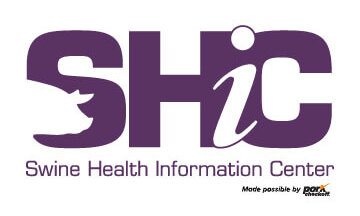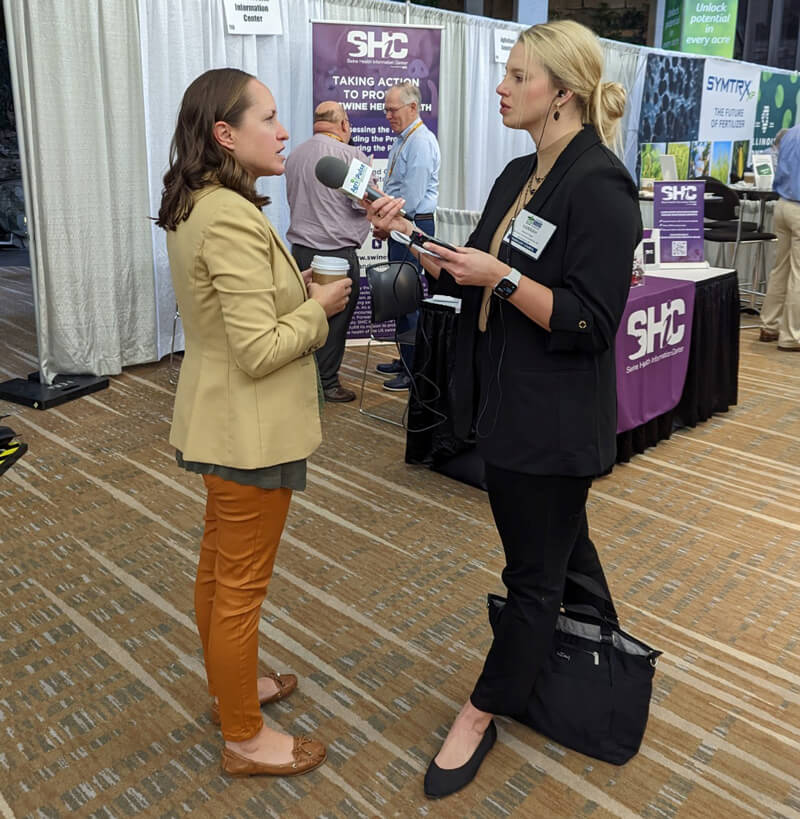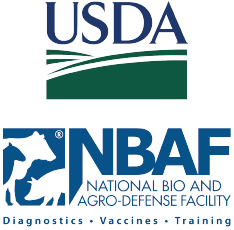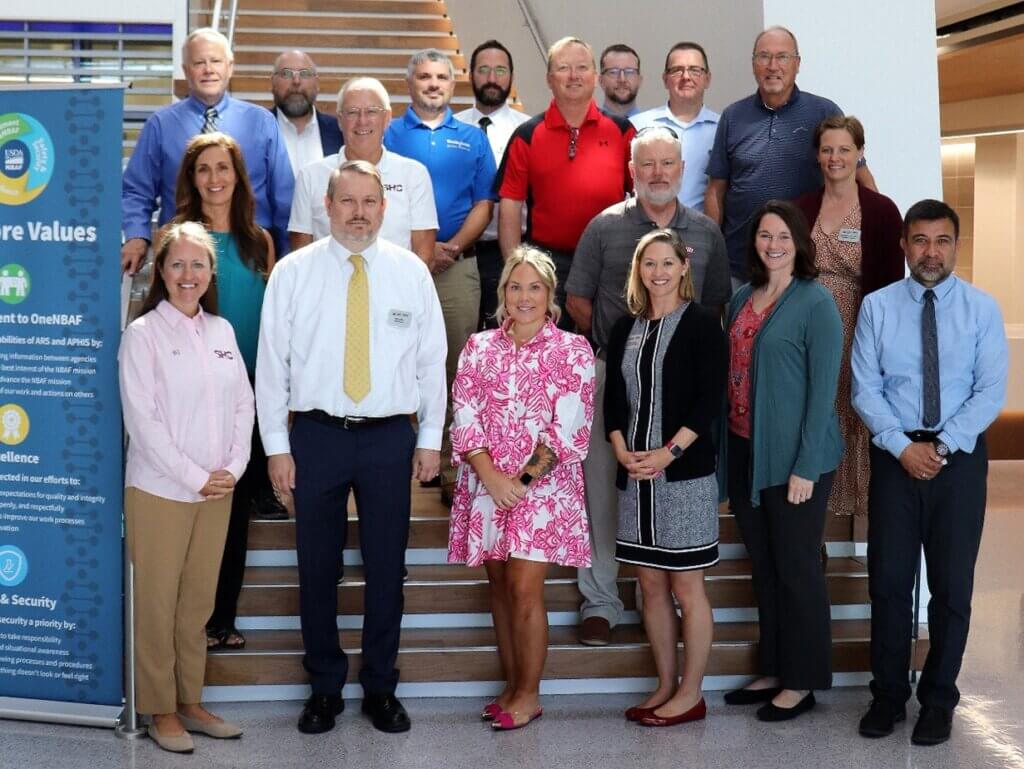

Sundberg sets retirement date; Niederwerder will become Executive Director
The Swine Health Information Center’s Executive Director, Dr. Paul Sundberg, has announced he will retire at the end of 2023. Upon accepting Dr. Sundberg’s retirement request, the SHIC Board of Directors moved to promote Associate Director Dr. Megan Niederwerder to Executive Director effective January 1, 2024. A transition plan is in place, ensuring a smooth handoff and business continuity for SHIC.
“Having Megan on board since April 2022 has allowed for interaction between her, Paul, and the Board so we can mesh her talents and strengths with the ongoing success we have had under Paul’s leadership,” remarked SHIC Board Chair Dr. Russ Nugent. “A person of Paul’s talents is not easily replaced, but we will all do our best to continue his legacy of SHIC success and the Board is very excited to have Megan taking us forward into the future.”
Dr. Niederwerder has been involved in, and exposed to, all facets of SHIC for over a year, according to Dr. Nugent. As associate director, Dr. Niederwerder oversees some key SHIC programs and efforts. While helping direct SHIC’s operations, and being mentored by Dr. Sundberg, Dr. Niederwerder grew to understand the organization’s efforts from the inside out. “We are all very clear on the SHIC mission statement. That keeps us grounded to our focus on a daily basis,” Dr. Nugent observed. The mission statement reads: The Swine Health Information Center, launched in 2015 with Pork Checkoff funding, protects and enhances the health of the US swine herd by minimizing the impact of emerging disease threats through preparedness, coordinated communications, global disease monitoring, analysis of swine health data, and targeted research investments. This statement guides not only day-to-day effort but the transition process as well.
“SHIC was formed because pork producers believed there was a better way to prepare for potential disease threats that were not yet in the US. That has been our focus since 2015,” commented Dr. Nugent. “SHIC’s staff must be well aware of pork production disease threats worldwide as well as have the vision and scientific contacts to lead an effort to assess risk, likelihood, magnitude, and ability for us to generate valuable insight into potential emerging diseases.” Dr. Nugent believes SHIC remains as relevant as ever, and said, “Our Executive Director must also have the vision to think outside the box and find new innovative ways to create value for Checkoff paying producers in this arena; for example recent and ongoing Wean-to-Harvest Biosecurity Program research will pay dividends for all producers against many existing and potentially emerging disease threats that may rob profit on an ongoing and/or future basis.”
Dr. Sundberg has been SHIC’s only Executive Director and for years, its only paid staff. “You simply do not replace someone like Paul Sundberg,” Dr. Nugent stated. “He has been an asset to this industry for years. Megan will use her vast talents, along with lessons and wisdom learned from Paul, to continue the strong legacy of SHIC to help US pork producers develop innovative ways to protect our ability to produce a healthy, sustainable, cost-effective food supply for our country. Megan won’t try to be Paul, but we sure won’t forget all that we have learned from him.”

The Swine Health Information Center is seeking candidates for the position of Associate Director due to the promotion of current Associate Director Dr. Megan Niederwerder to Executive Director as of January 1, 2024. Applications in the form of a curriculum vitae with a cover letter describing professional goals and why applicants are uniquely qualified to fill this position should be sent to Dr. Niederwerder at [email protected]. Full consideration will be given to applications received by September 22, 2023. Screening of applicants will start thereafter and continue until the position is filled with an anticipated start date of January 1, 2024.
SHIC, launched in 2015 with Pork Checkoff funding, protects and enhances the health of the US swine herd by minimizing the impact of emerging disease threats through preparedness, coordinated communications, global disease monitoring, analysis of swine health data, and targeted research investments.
SHIC’s Associate Director will help the Executive Director to lead the organization by assisting in directing overall operations and accountability and ensuring quality programs and services. Responsibilities and essential job functions include working with the Executive Director to provide oversight and implementation of the Center’s mission and objectives, budget, long range planning, strategic initiatives, and organizational structure. The Associate Director will interact closely with the pork community, leading efforts to build awareness of the Center and its mission and to build and maintain excellent working relationships.
To accomplish this, the Associate Director position demands a high level of visibility and interaction with pork producers, veterinarians, SHIC Board of Directors, academicians, allied industry, the National Pork Board, the National Pork Producers Council, the American Association of Swine Veterinarians, and other industry related audiences. The Associate Director position requires political discernment and sensitivity, broad and in-depth knowledge of the agricultural industry and organizations as well as strong familiarity with key pork industry organizations.
A full job description, including background requirements of the position and further details, is available here.

The Swine Health Information Center and American Association of Swine Veterinarians hosted a webinar on porcine sapovirus, a potentially emerging disease, on August 30 with 394 registrants from 22 countries Speakers shared diagnostic and field experience with PSaV including clinical presentation, production impacts, control/response strategies, and other insights. The webinar can be viewed here. Cumulatively, presenters offered advice on the risks of narrowly focusing on a single pathogen during a diagnostic investigation, which may result in missed detections of emerging or less common pathogens. A definitive lab diagnosis is necessary to know which pathogen or combination of pathogens are the cause of clinical disease in your swine herd.
Dr. Qiuhong Wang, The Ohio State University College of Veterinary Medicine, shared a historical perspective on PSaV. The Cowden strain was first detected in the US, together with rotavirus and astrovirus, by electron microscopy in the intestinal contents of a 27-day-old diarrheic pig from an Ohio swine farm in 1980. Dr. Wang said its genomic organization is that of a single-stranded, positive-sense RNA genome and shared illustrations of its structure. Dr. Wang discussed SaV’s classification which includes 19 genogroups of which eight infect pigs – GIII, GV-VXI. Further information in her presentation dove into details of PSaV etiology, prevalence at different farms and different ages of pigs, cell culture adaptation, and antibody assays.
Dr. Tom Petznick, practitioner with ArkCare in Omaha, Nebraska, shared his experience with discovery of PSaV on a client’s farm and the lessons learned in the process. Clinical signs on the farm included diarrhea and reduced average daily gain in pigs 7 days of age and older. Specifically, diarrhea was gravy to toothpaste-like in consistency and grey, yellow, yellowish-brown in color. Disease was self-limiting at or shortly after weaning with high morbidity/low mortality. The pigs didn’t respond to treatment. While there was low mortality, some pigs were too light at weaning and morbidity was variable. Affected pigs exhibited 1.5 pounds of lost wean weight.
Dr. Petznick pursued a definitive diagnosis in his client’s herd with planning, sample collection, and follow-up analysis. Initial results were negative for the usual causes – rotavirus, PEDV, PDCoV, and TGEV. The pursuit of a diagnosis continued with collaboration from Iowa State University’s Veterinary Diagnostic Lab, Merck Animal Health’s Sequivity division, the producer, and the Swine Health Information Center Diagnostic Fee Support. Next generation sequencing unexpectedly found PSaV. Though identified in the US in 1980, PSaV had not been identified as a significant cause for diarrhea in US herds for decades.
After implementing environmental analysis, sanitation and controlled/timed exposure in an unsuccessful effort to control the PSaV, Dr. Petznick investigated vaccination. In a four-step process including review of previous data, identifying the sample subject, analyzing fecal shedding vs weaning weight, and performing a vaccine field trial, the proof of concept was completed. In the field trial, staff and Dr. Petznick observed almost complete disappearance of diarrhea and weaning weights increased.
While other farms Dr. Petznick serves had similar clinical signs in pigs, the causative agents differed. Four farms in a swine production system were diagnosed with coccidiosis, sapovirus, rotavirus, and a co-infection of sapovirus/rotavirus, respectively. Diligent pursuit of diagnosis led to appropriate treatment and care.
Dr. Will Fombelle, practitioner with Carthage Veterinary Service, LTD, shared another field perspective. His observation included mid- to late-lactation piglet diarrhea which presented as could be expected with multiple pathogens, especially coccidia. Pudding-like diarrhea, rough hair, weaning weight deficits, and low mortality were all seen. Dr. Fombelle reflected on the easy assumption that diarrhea and low weaning weight were the result of coccidiosis and was surprised to learn it wasn’t the cause. By ruling out coccidia, they needed to “rule something in.” The process included tissue submission, rectal swabs, and fecal flotations.
In their evaluation, economics was given consideration. Dr. Fombelle shared the cost of weaning weight loss of 1 pound would equate to $22 per sow per year. This guided decision-making for treatment. He said vaccines with favorable efficacy are available to manage PSaV and recommended other practical management strategies as well.
Dr. Marcelo Almeida, Iowa State University Veterinary Diagnostic Lab, shared PSaV characteristics and results of work done to identify the causative agent from Dr. Petznick’s client’s herd outbreak. He said the epidemiology of PSaV shows it can be detected in pigs both with and without diarrhea and as such, detection does not equal causation. He also stated that PSaV can infect pigs at any age, but that detection rates are higher during suckling and nursery phases. Transmission, per Dr. Almeida, is fecal-oral. Early detection of PSaV in piglets is common but questions remain surrounding sow-to-piglet transmission and environmental contamination. For disinfection, sodium hypochlorite at 2.5 mg per liter for 30 minutes is effective.
For diagnosis, Dr. Almeida said samples should come from acutely affected pigs. Fresh and fixed samples of small intestines and colon are needed as well as feces. Tests used for diagnosis include histopathology, PCR, and RNAscope. Differentials for PSaV diagnosis are enteric coronaviruses, rotavirus, Cystoisospora suis, and others.
The final presenter was Dr. Yanyun Huang, sharing a western Canadian perspective as chief executive officer and anatomic pathologist with Prairie Diagnostic Services Inc. in Saskatoon, Saskatchewan, Canada. He said veterinarians affiliated with the Canada West Swine Health Intelligence Network and Canadian Swine Health Intelligence Network first reported PSaV being detected in cases of piglet diarrhea in the first quarter of 2023. No Canadian labs offered testing for PSaV at that time.
Their pursuit of a diagnosis followed a similar process as their US counterparts with sampling and other diagnostics being pursued when more common causes were ruled out. In work with the Government of Saskatchewan, Dr. Huang says their next steps are to fully validate PCR assays, implement surveillance in the province, and conduct further genetic analysis of more Canadian strains. He is encouraged by recent advancements in diagnostic technology increasing the ease of implementing a comprehensive investigative approach.
Do you have a recommendation for a topic to be addressed in this format? SHIC and AASV would like your input! Reach out to SHIC Executive Director Dr. Paul Sundberg at [email protected], Associate Director Dr. Megan Niederwerder at [email protected], or AASV Director of Public Health and Communications Dr. Abbey Canon at [email protected] with your webinar recommendations. Access previous webinars here. Webinars are conducted by ISU’s Swine Medicine Education Center.
The Swine Health Information Center, launched in 2015 with Pork Checkoff funding, protects and enhances the health of the US swine herd by minimizing the impact of emerging disease threats through preparedness, coordinated communications, global disease monitoring, analysis of swine health data, and targeted research investments. As a conduit of information and research, SHIC encourages sharing of its publications and research. Forward, reprint, and quote SHIC material freely. For more information, visit http://www.swinehealth.org or contact Dr. Paul Sundberg at [email protected] or Dr. Megan Niederwerder at [email protected].

Research proposals investigating tongue tips as a novel diagnostic sample type were the focus of a recently released SHIC RFP, now closed. Diagnostic investigation of tongue tips from stillborn pigs and neonatal mortalities may be used to gain information about PRRSV, or other pathogens, circulating during gestation and being vertically transmitted from the gestating sow to her litter. Tongue tips might also be used to monitor viral pathogen horizontal transmission in a variety of ages of pigs. Research into the use of tongue tip monitoring will help provide producers and their veterinarians with critical information that they may need to effectively respond to an emerging disease outbreak.
SHIC’s research priority is to understand the potential breadth of tongue tips as a sample type for monitoring emerging diseases. More information is needed about diagnostic test sensitivity or specificity using tongue tip tissues compared to other sample types such as neonate processing fluids; diagnostic lab processing procedures to support reliable, credible test results; comparing different pathogens’ tongue tip test results using whole genome sequencing; and confirming tongue tip test results using virus isolation.
Following, if tongue tip monitoring can be used to investigate vertical and/or horizontal disease transmission, more information is needed about how to apply tongue tip monitoring to support recovery from emerging diseases. Therefore, using tongue tips to achieve herd PRRS stability or elimination as a model for an emerging disease response needs to be investigated.
Results of this research will be shared when available.

National Bio and Agro-Defense Facility directors and research leaders invited Swine Health Information Center Board of Directors members and staff to tour the new facilities in Manhattan, Kansas, in late July. The tour and presentations provided insight into the new facilities’ abilities to achieve its mission of protecting the US livestock industry against transboundary, emerging, and zoonotic animal diseases. The team also explored potential collaboration to meet SHIC’s objectives of minimizing the impact of emerging disease threats through preparedness, and targeted research investments.
SHIC Board of Directors members Drs. Russ Nugent, Daryl Olsen, Jeremy Pittman, and Paul Ruen attended along with Executive Director Dr. Paul Sundberg and Associate Director Dr. Megan Niederwerder.
Per the USDA website, NBAF will replace the Plum Island Animal Disease Center, a biosafety level-3 facility. When complete, USDA Agricultural Research Service and Animal and Plant Health Inspection Service will transfer their research and diagnostic missions to NBAF and will jointly operate the facility. The USDA team at NBAF currently has access to the facility and started a phase of transition from Plum Island Animal Disease Center to the new site. NBAF is the first high-containment, biosafety Level 4 facility for livestock in the US, which will enable scientists to work on the most high-consequence zoonotic animal diseases — those that can infect both livestock and people.
In addition to working on protecting the US against transboundary, emerging, and zoonotic animal diseases threatening our food supply, agricultural economy and public health, NBAF will also be a critical component of a key USDA priority—the development of animal vaccines and other countermeasures for the detection of diseases that threaten livestock, other animals and domestically-produced food. NBAF’s enhanced diagnostic and training capabilities will further contribute to its mission of protecting the nation from foreign or transboundary animal diseases.


This month’s Domestic Swine Disease Monitoring Report brings Purdue Animal Disease Diagnostic Laboratory on board to the SDRS. The addition was a request from swine stakeholders, increasing the laboratory network contributing to the project. Also, the report brings information about the historical lowest PRRSV-positivity in the wean-to-market category (26%). However, regional PRRSV activity is above expected in Illinois and Ohio. For enteric coronaviruses, a slight increase in positivity from sow farms was detected in August. Regional PDCoV positivity is above the expected in Kansas; PEDV in Missouri, and North Carolina. For Mycoplasma hyopneumoniae and PCV2, the positivity in wean-to-market category had a substantial increase in August (MHP- 15% to 21%; PCV2 – 34% to 43%). In the confirmed tissue diagnosis database, there were alarms for an increased number of coccidiosis cases. In the podcast, the SDRS hosts talk with Dr. Craig Bowen about Purdue ADDL contributions and motivations to join the SDRS project as well as expected benefits for swine stakeholders.

In the September Global Swine Disease Monitoring Report, the first report of ASF in Sweden is shared. Seven dead boars were found in Fagersta, approximately 124 miles northwest of Stockholm, one tested positive for ASF with more testing being done (read the 9/6/2023 Reuters report here). Also, learn about release of an updated ASF Red Book by USDA APHIS. A new outbreak of ASF was reported in Lombardy, Italy. In Brazil, FMD control continues. Read about surveillance at points of entry where authorities from the Antique province of The Philippines seized over 1100 pounds of illegal pork products coming into that country from ASF-positive regions. In the US, Customs and Border Protection found uncertified pork products in the luggage of travelers entering the country from Vietnam.
Copyright 2025 | Swinehealth.org | Website by Heartland Marketing Group